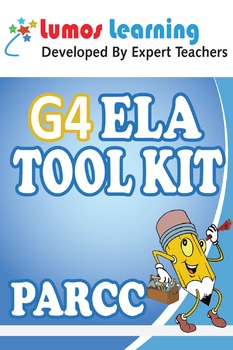Grade 4 English Language Arts (ELA) Tool Kit for Educators, PARCC Edition
Lumos Learning
842 Followers
Grade Levels
4th, Staff
Resource Type
Standards
CCSSRL.4.1
CCSSRL.4.2
CCSSRL.4.3
CCSSRL.4.4
CCSSRL.4.5
Formats Included
- Open Publication Structure eBook File
Pages
110 pages
Lumos Learning
842 Followers
Description
Grade 4 English Language Arts (ELA) Tool Kit for Educators: Standards Aligned Sample Questions, Apps, Books, Articles and Videos to Promote Personalized Learning and Student Engagement, PARCC Edition
This book is a directory of educational resources that every teacher and parent will find useful while helping their students learn fourth grade English Language Arts (ELA) skills. It is designed to help educators easily find high quality resources to create personalized learning and differentiated instruction. It not only includes access to several resources developed by Lumos Learning, but also has information about a vast array of apps, books, videos and websites developed by other publishers, teachers and developers.
This guidebook includes:
* Sample questions that are aligned to the Common Core Standards.
* Practice tests similar to the PARCC assessments.
* Lumos EdSearch to discover educational mobile apps, books, videos, Khan Academy resources, library information, and more.
* A special hyperlink to create a free teacher account that has an item bank of hundreds of questions along with additional tools to supplement your classroom instruction.
* Printable worksheets related to various standards.
* Blogs written by expert teachers on a wide range of topics to help teachers and parents.
This book is a directory of educational resources that every teacher and parent will find useful while helping their students learn fourth grade English Language Arts (ELA) skills. It is designed to help educators easily find high quality resources to create personalized learning and differentiated instruction. It not only includes access to several resources developed by Lumos Learning, but also has information about a vast array of apps, books, videos and websites developed by other publishers, teachers and developers.
This guidebook includes:
* Sample questions that are aligned to the Common Core Standards.
* Practice tests similar to the PARCC assessments.
* Lumos EdSearch to discover educational mobile apps, books, videos, Khan Academy resources, library information, and more.
* A special hyperlink to create a free teacher account that has an item bank of hundreds of questions along with additional tools to supplement your classroom instruction.
* Printable worksheets related to various standards.
* Blogs written by expert teachers on a wide range of topics to help teachers and parents.
Total Pages
110 pages
Answer Key
Included
Teaching Duration
N/A
Report this resource to TPT
Reported resources will be reviewed by our team. Report this resource to let us know if this resource violates TPT’s content guidelines.
Standards
to see state-specific standards (only available in the US).
CCSSRL.4.1
Refer to details and examples in a text when explaining what the text says explicitly and when drawing inferences from the text.
CCSSRL.4.2
Determine a theme of a story, drama, or poem from details in the text; summarize the text.
CCSSRL.4.3
Describe in depth a character, setting, or event in a story or drama, drawing on specific details in the text (e.g., a character’s thoughts, words, or actions).
CCSSRL.4.4
Determine the meaning of words and phrases as they are used in a text, including those that allude to significant characters found in mythology (e.g., Herculean).
CCSSRL.4.5
Explain major differences between poems, drama, and prose, and refer to the structural elements of poems (e.g., verse, rhythm, meter) and drama (e.g., casts of characters, settings, descriptions, dialogue, stage directions) when writing or speaking about a text.


